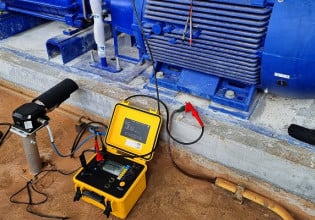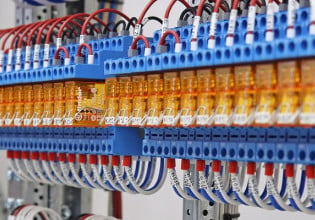Understanding Peristaltic Pumps
Peristaltic pumps are used in applications where contamination of the fluid passing through the pump is unacceptable. In this article, learn how these pumps work and see the different applications where they're used.
Piston pumps and diaphragm pumps can be used for high-precision fluid handling. But an inherent problem with them is that the mechanism of the pump is in direct contact with the fluid to be pumped. This is a potential avenue for contamination of the fluid and can pose a significant issue when fluid with a sensitive nature is dispensed. That is where peristaltic pumps come in.
What are Peristaltic Pumps?
The peristaltic pump was patented in 1855 by J.D. Bradley and Rufus Porter, and subsequent improvements were made over the next century. In 1932, heart surgeon Dr. Michael DeBakey designed a pump for blood transfusions. Later the same technology was used in other medical devices like cardiopulmonary bypass systems. It is now used in many industry verticals including medical devices, laboratories, manufacturing, and landscaping.
The most commonly observed use of peristaltic pumps is in aquariums to pump fresh air into the water tank. Unlike other precision pumps, peristaltic pumps do not require valves to control the direction of fluid flow.

Figure 1. A peristaltic pump.
Peristaltic pumps are positive displacement pumps that insulate the fluid dispensed with the pump mechanism and external environment. The fluid passes through a flexible tube within the pump and it is pushed by a roller moving the fluid forward as shown in the image above. The shoes of the roller pinch the tube and move the fluid in the direction of rotation of the roller. Peristaltic pumps are also called roller pumps. In the schematic of a peristaltic pump given below, the roller has three shoes, moving the fluid in a clockwise direction.

Figure 2. A simplified diagram of a peristaltic pump. Image courtesy of PMD.
It is obvious from the schematics that peristaltic pumps cannot deliver a smooth continuous flow of fluid. The fluid is dispensed in pulses. The amount of fluid that is dispensed in one pulse is equal to the volume between the two pinched portions of the tube, i.e the volume of the tube between two shoes of the roller.
Peristaltic pumps are used for high-precision fluid dispensing, where the liquid to be dispensed is in the microliter range and the tolerances are in the nanoliter range. Peristaltic pumps can reliably deliver such a high degree of accuracy and precision. The resolution of the pump is dependent on the number of shoes (the distance between them) on a roller. The higher number of shoes (less distance between shoes), the higher the resolution.
How Does a Peristaltic Pump Work?
The peristaltic pump is inspired by mechanisms involved in the metabolic process that happens in the human body, especially the digestive tract. The mechanism is called peristalsis. As per Britannica encyclopedia, “Peristalsis, involuntary movements of the longitudinal and circular muscles, primarily in the digestive tract but occasionally in other hollow tubes of the body, that occur in progressive wavelike contractions.”
When food travels from mouth to stomach through the esophagus, it would have slid in a free fall to the stomach. But with the peristalsis movement in which the muscle contracts and expands to move the food in a regulated manner. It is also this same mechanism that allows for the regulated intake of air by lungs, movement in the small intestine, dispensing of fluids like bile in the body, and reproductive organs. These mechanisms are the inspiration for peristaltic pumps.

Figure 3. A simplified look at peristalsis in the esophagus. Animation courtesy of Auawise. [CC BY-SA 4.0]
In pumps, the flexible tube is contracted by the shoe attached to the roller and the fluid is pushed forward through the tube by the roller in the same direction as the rotation of the motor to which the roller is attached. According to the movement characteristic required, a servomotor or stepper motor can be used to drive the roller. The rollers can also be changed to different designs according to the desired flow characteristics.

Figure 4. How a peristaltic pump works. Image courtesy of Watson Marlow.
The flexible tube in the pump can be made of PVC (polyvinyl chloride), fluoropolymer, or silicone rubber. The main concern is the contamination that can be caused to the dispensed fluid. The choice of material should be such that the fluid and the tube should be inert to each other. Due to constant contraction, expansion, and pinching by roller shoes the tubes need to be regularly changed.
Applications and Specific Industry Use
The significant advantage of peristaltic pumps is that there is no need for values to control the direction of fluid flow. The direction of flow can also be changed easily, just by changing the direction of the motor. It is also easy to achieve a high level of resolution for peristaltic pumps. As mentioned earlier the number of shoes on the roller can be increased to increase resolution along with a high-resolution motor to drive the roller.
The major downside of peristaltic pumps is that they can be used only for smaller supply rates for fluids. The shoes of the roller assist in the movement of fluids. So fluids with high viscosity and even semi-solids like slurry can be dispensed using peristaltic pumps.
Due to these characteristics, peristaltic pumps find application in large industries that require high precision, accuracy, and purity of the fluid dispensed. These pumps have a wide range of applications in the medical field as part of many medical devices. The following are some use cases of peristaltic pumps in popular industries.
Medical applications:
- Infusion pumps
- Dialysis equipment
- Open heart bypass pump equipment
- Blood transfusion and apheresis
Laboratory applications:
- Analytical chemistry testing
- Auto analyzers
- Exclusion of dirt
- Carbon Monoxide observers
- Chemical handling
Architecture:
- Decorative waterfalls & fountains
- Handling water and wastewater
- Air pump in aquariums
Manufacturing:
- Food manufacturing
- Industrial dishwasher clean aid machines
- Pharmaceutical production
- Transporting solid slurries





